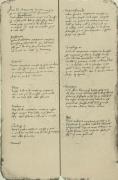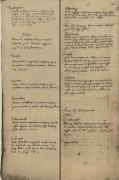Leases of abandoned farmsteads in Warmia 1516–1521
Original: last four pages in Olsztyn, Archive of the Warmia Archdiocese, II, 55, fol. 42-42v. Photocopy: Münster, Ermlandhaus, Nachlass von Hans Schmauch.
Copernicus, having been duly elected to that office, became the "Administrator of the Property Held in Common by the Venerable Chapter of Varmia" for a term of three years, beginning 11 November 1516. The Chapter's statutes provided that the "elected administrator shall swear that he will present to the Chapter or its deputies in its entirety the whole income from the districts of Melsac and Olsztyn, when he has collected it." That income was collected from the peasants (subditi) bound to the soil owned by the Chapter and divided into parcels (mansus). A peasant (colonus, villanus) who took possession of a parcel owed an annual money rent (census) as well as several unpaid labor servitudes ("rusticalia servitia, which in the vernacular are called Scharwerk"). The administrator was required to maintain the "ledger (registrum) in which the villages, rentals, and property of the Chapter are recorded", and "to render an accounting of the same and present it to the Chapter" "when he is relieved of the office of administrator."
The combined burden of rent and servitudes was so heavy that many a peasant ran away, either to look for a job in a town or for a less oppressive situation in another village. The frequent wars made conditions even worse, so that in 1500 nearly one-fourth of the Olsztyn parcels were unoccupied. In order to attract a settler, the administrator could exempt him for one or more years from the rent or servitudes or both. The new settler would usually receive the buildings (house, barn, stable), livestock (horse, ox, cow, pig, goat), equipment (wagon, plough, tools), and seed. The transaction was recorded by the administrator in a special ledger called Locationes. In the law of ancient Rome, locatio was the term for a lease. In these Varmia Locationes the lessor was the Chapter, which retained ownership (dominium) of the land. The lessee was often required to furnish one or more guarantors, who faithfully promised that he would not run away within a specified time. If he stayed beyond that time, presumably he was satisfied and would remain until the end of his working life. In that case his holdings would be inherited by his heirs. But if more desirable parcels became available during his lifetime, with the Chapter's permission he could sell his holdings and buy others, either in his own village or in another village within the Chapter's domain. He could not move into the bishop's domain in the diocese of Varmia or leave the diocese.
When a peasant ran away, if he left anything of value on his parcels, it was taken into temporary custody by the village's overseer (scultecus). Whatever the administrator later awarded to the new occupant was given to him by the overseer, particularly the animals. Sheep do not appear in these Leases, a pastor being a herdsman rather than a shepherd. The parcels contained pasture land (prata) as well as arable land (agri).12 The chief cereal was rye (siligo), with oats (avena) and barley (ordeum) less prominent. Buckwheat (gricka), millet (frumentum aestivum), and flaxseed (lini semen) were also grown. Among vegetables, peas (pisae) are mentioned. Farm equipment (suppellex) comprised a wagon (plaustrum), plough (aratrum), iron plowshare (ferramentum pro aratro), ax (securis), scythe (falcastrum), sickle (falx), kettle (caldar), and water barrel (tona aquaria). Conspicuous features of the landscape were the mill (molendinum), producing flour (farina), and the tavern (taberna), producing good cheer, if not inebriety.
It was the overseer's duty to find a runaway peasant and bring him back. Pending his return, the parcels he abandoned might be leased to another peasant. This new lease was conditional, however, being valid only until the fugitive reappeared on the scene. If he stayed away a long time and was not replaced, the abandoned parcels would naturally revert to their original wooded state (insilvatus). The longer they remained overgrown, the longer the exemption from rent and servitudes required to attract a cultivator.
If a peasant ran away after having sown the winter fields, and he was replaced before harvest time, the new lessee usually received one-quarter of what bad been sown (quarta pars satorum). Presumably this fraction was his reward for bringing in the crop, while the remaining three-quarters escheated to the Chapter as overlord. Exceptionally, the new lessee received the entire winter crop (sata hiemalia).
The precise provisions of a lease were decided by the administrator, who used his own discretion in granting or withholding an exemption (libertas) from the rent and/or servitudes. If the new lessee was fairly prosperous, and the parcels in good condition, the lease carried no exemption (sine libertate, absque libertate). But if the situation warranted, the administrator could grant relief from the next annual payment of rent (libertas census proximi). In more serious cases the exemption could be extended to three years (libertas triennis, libertas iii censuum), four years (libertas iiii annorum a censu et servitio), or six years (libertas annorum vi).
Exemption from the servitudes usually included all of them, but exceptionally a peasant was required to assist in the hunt (venatio) while being excused from all the other servitudes. In one case, the exemption granted by Copernicus to an elderly couple without sons was permanent (concessi libertatem). In the same spirit when Peter, an aged peasant, sold his 1 1/2 parcels, the annual rent (l/2 mark) due from the 1/2 parcel was kept by the Chapter, "which graciously donated the l mark [due from the remaining parcel] to the aforesaid Peter for life." In helping a new settler to establish himself, Copernicus sometimes added to the inventory left by the previous occupant. Where an outright gift seemed excessively generous, a loan took its place. While such help in the form of gifts and loans was frequently extended to those who worked hard and obeyed the law, harsh punishment was meted out to criminals.
The transactions recorded in these Leases were entered (for the most part) in chronological order under the appropriate year. The Chapter's administrative year, however, did not coincide exactly with the calendar year, for the former began on St. Martin's day, 11 November. Hence, a transaction occurring on 10 December 1516 appears in the Leases under 1517. Copernicus used both the ecclesiastical and secular calendars. Thus, he referred to one and the same day as xii Martii (12 March) and Sabbatum ante Invocavit.
As witnesses of some of the transactions which he authorized, Copernicus names either or both of his servants. He calls the older one, Albert Szebulsky, his famulus," while referring to the younger one, Jerome (whose surname is unknown), as his errand boy (puer).
In recording the names of the numerous Polish peasants involved in these Leases, Copernicus "registered the phonetic characteristics of the Polish language correctly."1 Yet in the same entry Copernicus wrote both Czepan and Zcepan2. This transposition of the first two letters indicates that he was trying to reproduce phonetically the sounds he heard, and provides no basis for the conclusion that he "not only knew the Polish language but spoke it fluently enough to be able to use it in his dealings with Polish peasants"3. He wrote the Polish names as well as could be done by an intelligent and conscientious administrator essentially unfamiliar with that language. How did he and his German-speaking predecessors and successors as administrators communicate with their Polish subjects? In this region and period of rapid demographic change, Poles were migrating northward in increasing numbers into a land previously populated predominantly by German-speaking peasants. In these commingled groups, persons familiar with the limited bilingual vocabulary required for these transactions may not have been hard to find.
The earliest Copernican scholar to pay any attention to these Leases was Franz Hipler, who incorporated them to a restricted extent in the Regesta Copernicana section of his Spicilegium Copernicanum (Braunsberg, 1873), pp. 272-277. Then Leopold Prowe printed some extracts4. The first complete publication of the Leases, with photofacsimiles of the manuscript and translation into Polish, was the contribution of Marian Biskup5, which was made possible by a notable example of international scholarly cooperation. For, the manuscript had suffered severe damage during World War II, only its last four pages being preserved intact. Fortunately, these and all the other pages had been photocopied for Hans Schmauch, whose untimely death in 1966 prevented him from publishing the entire manuscript. After his death, his material was made available to Biskup by the management of Zeitschrift für Geschichte und Altertumskunde Ermlands. Such heartwarming collaboration between Germans and Poles bodes well for the future relations of these two neighboring great nations.
From Edward Rosen's Introduction published in: Nicholas Copernicus Minor Works (Warsaw-Cracow, 1985).
Further reading:
- Kopernik Mikołaj, Pisma pomniejsze, Warszawa 2007.
1 Mikołaja Kopernika lokacje łanów opuszczonych, ed. Marian Biskup (Olsztyn, 1970), p. 33, 28-29.
2 Ibidem, Plate 2/7, 10; p. 78/12, 14.
3 Ibidem, p. 33.
4 Franz Hipler, Spicilegium Copernicanum (Braunsberg, 1873), pp. 272-277.
5 Leopold Prowe, Nicolaus Coppernicus (Berlin, 1883), vol I, part II, 90-93. Mikołaja Kopernika lokacje… (see note 1); Mikołaj Kopernik, Lokacje łanów opuszczonych, ed. M. Biskup (Olsztyn, 1983).
 English (United Kingdom)
English (United Kingdom)  Polski (PL)
Polski (PL) 












